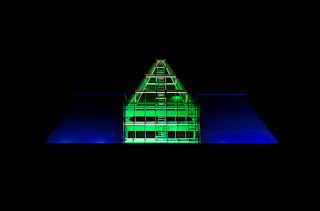Aim: The aim of this exercise is to explore the variety of lighting effects and colour in artificial light.
Approach and results:
For this exercise I had a number of places and buildings in mind. Setting up the camera for the different types of shot was important. Despite being all night shots, the desired results needed particular settings. Tripod mounted shots did not need a high ISO whereas handheld and long focal length invariably did unless it was very bright. I used centre or spot metering for specific subjects like buildings and evaluative for the more general shots where the whole scene was important. A camera does not recognise when you want atmosphere so it was necessary to compensate for some of the overly bright images in order to get the end result.
I tried a number of times to get an indoor shot of a large space with lots of people but this restricts you to shopping centres and the security was rather sharp. I'll try again sometime with a smaller camera.
This first shot is of the top of a local office building called the pyramid. I wanted to isolate the building from it's surroundings so I waited for a clear night with no cloud cover or light pollution. I used tungsten WB to keep the colours cool. The green especially would turn more yellow with daylight balance.
 |
| I sec ISO200 tripod |
 |
| I/8 sec ISO800 handheld |
 |
| I/8 sec ISO800 handheld |
 |
| I/125 sec ISO400 handheld |
 |
| I/50 sec ISO1600 handheld |
 |
| I/30 sec ISO400 handheld |
 |
| I/45 sec ISO800 handheld |
 |
| I/45 sec ISO200 handheld |
 |
| 13 secs ISO200 tripod |
 |
| I0 secs ISO200 tripod |
 |
| I sec ISO200 tripod |
 |
| I0 sec ISO200 tripod |
 |
| I/80 sec ISO800 handheld |
 |
| I/100 sec ISO800 handheld |
Night photography is very wide ranging with quite different techniques needed for different shots; moving and static subjects, dim or brightly lit and different colour temperatures.
When it came to white balance I would quite often use what I prefered for mood rather than accuracy. The photographer creates the image and this is just another weapon in the photographers arsenal. Daylight balance was invariably too warm but there are a wealth of different types of artificial lighting these days and more and more of them have a more natural balance. The AWB on my new camera is far more accurate than on my old camera and I found that I could rely on it far more.
Cameras are far better at dealing with high ISOs these days and I found I could shoot most scenes handheld unless deliberate streaks were the desired outcome. If noise becomes an issue then shooting in B&W and presenting it as grain is also an option.
No comments:
Post a Comment